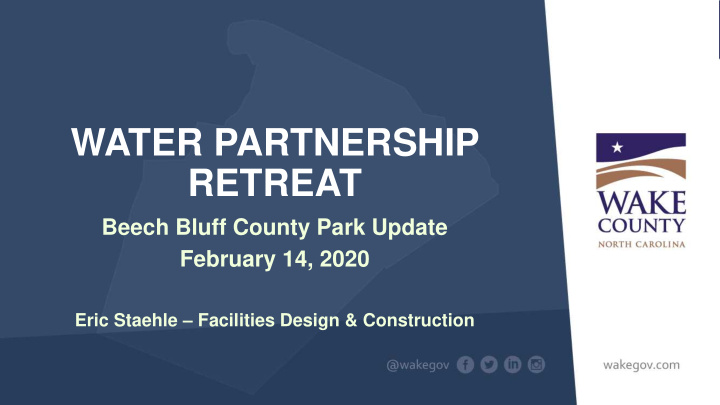



WATER PARTNERSHIP RETREAT Beech Bluff County Park Update February 14, 2020 Eric Staehle – Facilities Design & Construction
Today’s Discussion • Planning and Design Framework • Beech Bluff County Park o Site Overview o Planning / SITES o Stormwater / Energy o Native Landscape / Public Art BEECH BLUFF CP 2
Planning and Design Framework • BOC Growth and Sustainability Objective GS1 (2018) “Implement a comprehensive approach for preserving open space and developing parks and o greenways to address gaps, leverage opportunities and resources, and enhance collaboration with municipal partners. Set priorities and implement strategies for the use of new bond funds for parks, open space and greenways. “ • Renewable Energy Resolution (2018) • Native Plants Resolution (2018) • Public Art Policy (2017) • Master Plan Community Input (2018-2019) • Wake Design Guidelines / Energy Guidelines BOND PRIORITY PROJECT: BEECH BLUFF COUNTY PARK 3
Middle Creek Watershed / Ecology 4
County Context • 305 Acres • Was “SE County Park” • Adjacent to Fuquay Varina and Garner • No County Park facilities in this area 5
Site Environmental Context Floodplain Bluffs Streams Forest Fields 6
Site Habitat Section 7
Site Views 8
Site Context • Adjacent neighborhoods • Continued new development 9
Creating the Mission Statement Beech Bluff County Park aims to provide a universally inclusive recreational amenity to the residents of Wake County and all visitors focusing on the following core principles: • Protect, Restore and Enhance Ecological Diversity • Elevate Historical and Cultural Significance • Promote Human Health and Wellness The park is to be a model of Resiliency and Stewardship 10
Creating the Master Plan 11
Evaluating Program Options 12
Beech Bluff Master Plan 13
Beech Bluff County Park 14
Defining the Project Initiatives • Sustainable SITES Initiative • Green Stormwater Infrastructure • Solar Energy Considerations • Park Center Buildings and Site Integration • Public Art as part of the design process • Urban Agriculture • Community Gardens / Demonstration Gardens 15
“Creating ecologically resilient communities” • Rating system for sustainable land development projects Rick Fisher’s Photography • Administered by GBCI Charlotte Brody Discovery Garden • SITES and LEED synergies • 2 North Carolina certified projects Art Howard 16 Horseshoe Farm Nature Preserve
SITES Considerations 17
SITES Considerations = Educational Opportunity 18
Programming the Park Design Subgroups • Site • Architecture • Education • Stormwater • Cultural History • Agriculture / Comm. Gardens • Landscape / Meadows 19
Developing the Site Plan Native Prairies Short Leaf Pine Canopy Long Leaf Pine Walk Bridge Park Open Play Fields Center Agricultural Fields Playground Community Gardens Wildlife Observation Agriculture / Trails Gardens / Event Area Shelters Maintenance Facility 20
Integrating GSI and Energy Green Stormwater Infrastructure Energy Considerations Rain Gardens / Bio Retention Photovoltaic Roof Panels Bioswales Photovoltaic Array Permeable Pavers Geothermal Wells Rainwater Harvesting Cisterns 21
Park Center Area – GSI and Energy Photovoltaic Roof Panels Rainwater Cisterns Rain Gardens / Bio Retention Geo Thermal Wells Permeable Pavers 22
Site Water Opportunities • Design functional stormwater as amenities • Integrate throughout the park • Provide signage for education and awareness • B enefits of preserved forested areas… • Treatment trains… • Rainwater harvesting… • Provide opportunity for stormwater training workshops – public and professionals • Engage local schools • Monitoring – Pre and Post Construction 23
Park Center Buildings - Energy Classrooms Park Center/Office/Displays RR 24
Park Center Buildings 25
Agricultural / Event Area - Energy 26
Native Landscape / Plants Why Native Species: • Encourage stewardship of the land • Celebrate natural diversity • Provide food and shelter for wildlife • Create a sense of place • Reduce water and maintenance needs • Withstand regional weather extremes • Provide an educational opportunity • Create a model for other development Goal = 70% minimum native species FV Library = 90% Preserves / Parks = 100% 27
Integrating Public Art “As visual storytellers we love creating site -specific artwork that deepens people’s relationship to a place ”. “We relish the opportunity to make emblematic and engaging artwork for the Southeast County Park that reflects the important goals of environmental education and an active lifestyle, creating an atmosphere of curiosity and personal investment in wildlife for all who visit the park”. “Natural and cultural stewardship would be at the forefront of our minds when collecting and developing stories and concepts to interact with the extensive and diverse ecosystems of the park ”. 28
Questions? IT’S A MAGICAL WORLD OL’ BUDDY… LET’S GO EXPLORING ! 29
Recommend
More recommend